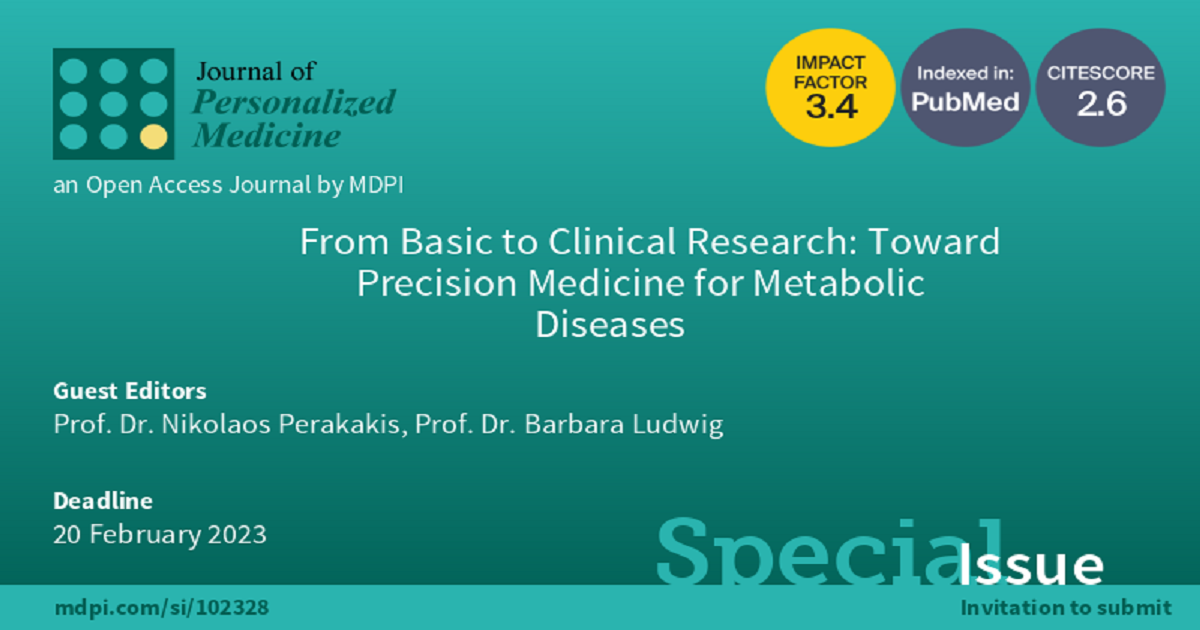From Basic to Clinical Research: Toward Precision Medicine for Metabolic Diseases
A special issue of Journal of Personalized Medicine (ISSN 2075-4426). This special issue belongs to the section "Clinical Medicine, Cell, and Organism Physiology".
Deadline for manuscript submissions: closed (20 February 2023) | Viewed by 35235

Special Issue Editors
Interests: NAFLD; diabetes; obesity; nutrition; exercise; omics
Special Issue Information
Dear Colleagues,
Metabolic diseases have become a major health hazard of the modern world, affecting a great part of the population and demonstrating a continuously increasing prevalence. Remarkable advancements in recent decades in diagnostic procedures and in available treatments have led to profound improvements in patient care. However, increasing evidence from extensive research in recent decades has shown that disease and population heterogeneity have a major impact on diagnostic success, on the prediction of the course of metabolic diseases and on treatment response.
This Special Issue focuses on cutting-edge developments in the diagnosis, understanding and treatment of metabolic diseases, such as obesity, diabetes, hyperlipidemia, hypertension and non-alcoholic fatty liver disease. We invite the submission of original research (basic, clinical and epidemiological studies), review and meta-analysis articles on the latest advances toward understanding and combatting metabolic diseases in the era of precision medicine. Topics of particular interest include: a) Novel diagnostic, prognostic and preventive approaches (including, but not limited to patient-subphenotyping, biomarker discovery, risk score development), b) Novel approaches of treatment, including pharmacologic and non-pharmacological interventions (e.g., nutritional, exercise, transplantation, operation) as well as combination therapies, c) Targeted treatment, i.e., treatment of groups with unique characteristics, d) Novel pathophysiological mechanisms.
Prof. Dr. Nikolaos Perakakis
Prof. Dr. Barbara Ludwig
Guest Editors
Manuscript Submission Information
Manuscripts should be submitted online at www.mdpi.com by registering and logging in to this website. Once you are registered, click here to go to the submission form. Manuscripts can be submitted until the deadline. All submissions that pass pre-check are peer-reviewed. Accepted papers will be published continuously in the journal (as soon as accepted) and will be listed together on the special issue website. Research articles, review articles as well as short communications are invited. For planned papers, a title and short abstract (about 100 words) can be sent to the Editorial Office for announcement on this website.
Submitted manuscripts should not have been published previously, nor be under consideration for publication elsewhere (except conference proceedings papers). All manuscripts are thoroughly refereed through a single-blind peer-review process. A guide for authors and other relevant information for submission of manuscripts is available on the Instructions for Authors page. Journal of Personalized Medicine is an international peer-reviewed open access monthly journal published by MDPI.
Please visit the Instructions for Authors page before submitting a manuscript. The Article Processing Charge (APC) for publication in this open access journal is 2600 CHF (Swiss Francs). Submitted papers should be well formatted and use good English. Authors may use MDPI's English editing service prior to publication or during author revisions.
Keywords
- obesity
- diabetes
- NAFLD
- NASH
- hyperlipidemia
- hypertension
- omics
- nutrition
- exercise
Benefits of Publishing in a Special Issue
- Ease of navigation: Grouping papers by topic helps scholars navigate broad scope journals more efficiently.
- Greater discoverability: Special Issues support the reach and impact of scientific research. Articles in Special Issues are more discoverable and cited more frequently.
- Expansion of research network: Special Issues facilitate connections among authors, fostering scientific collaborations.
- External promotion: Articles in Special Issues are often promoted through the journal's social media, increasing their visibility.
- e-Book format: Special Issues with more than 10 articles can be published as dedicated e-books, ensuring wide and rapid dissemination.
Further information on MDPI's Special Issue policies can be found here.






